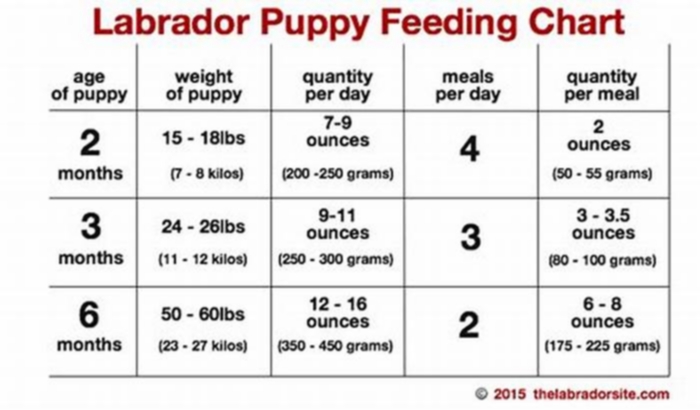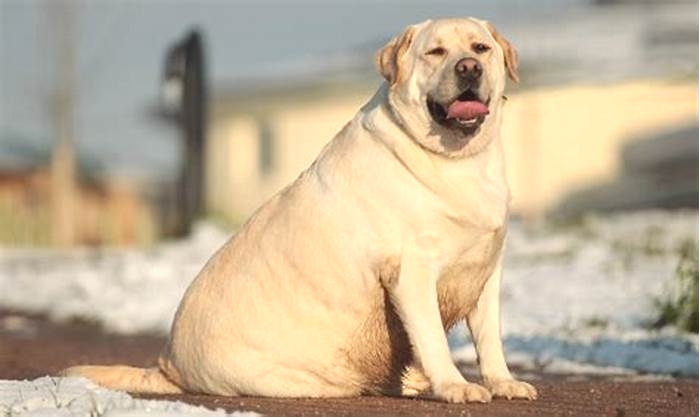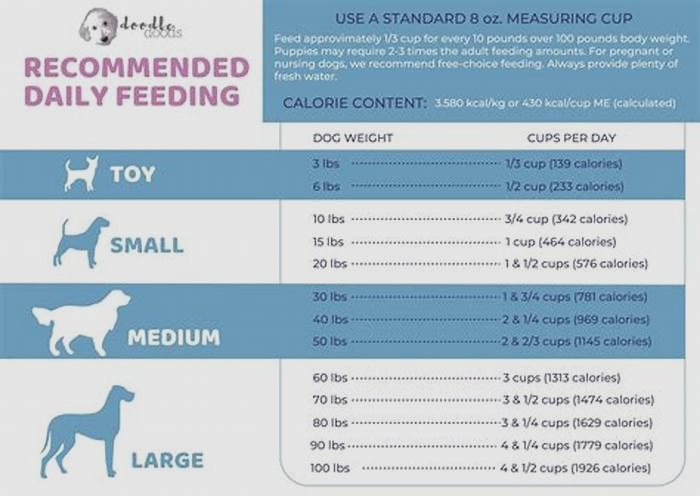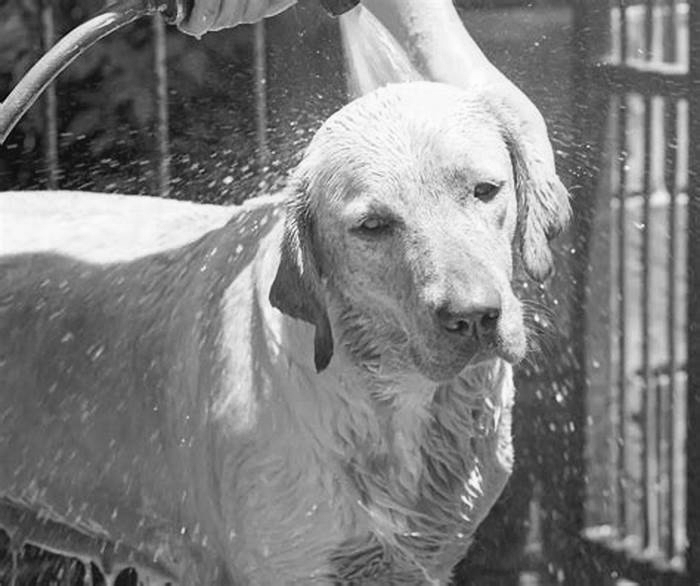How big will my Labrador get

Labrador Retriever Growth Chart: Male And Female Weight & Height
Labrador Retrievers are the most popular dog in America, and its easy to see why. Their sunshiny disposition, temper, and love of children make them great family dogs. Labs get to be pretty large, so it begs the question, How large does a Labrador get? Its always important to monitor puppies to see if theyre growing up strong, including their weight and height. This is one of the best ways to ensure that your dog has the best chance at optimal health throughout its life.
 Advertisement
Advertisement Its certainly true that every dog is unique and thus may be bigger or smaller than average sizes. Still, its always a good idea to measure and see if they are on track. Some Labradors grow bigger faster than others, whereas others will take longer to develop. Since we know that Labs are relatively large dogs, we should be keeping track of their milestones and understanding how well our dogs are growing relative to the norm.
This is a comprehensive guide to your Labrador Retrievers growth through puppyhood. We take a look at month-by-month comparisons of your puppys growth and examine the statistics of your average adult Labrador. We also provide a handy growth chart to provide a quick reference point throughout your dogs growing years. Then, we consider the different factors that go into your dogs growth. Lastly, we answer the most frequently asked questions about a Labrador Retrievers growth.
What To Expect

We know that Labrador Retrievers get to be pretty big and strong dogs. However, its always good to take a look at the specifics, especially to see how your puppy is developing. This way, you can be prepared to take care of them in the best way possible. Growth charts are helpful, but they will not tell us what we need to know about our puppies as they are developing. Learning the ins and outs of caring for your dog during this delicate time can really make all the difference in how they turn out as adults. Before we move to the puppy growth timeline, lets look at a few reminders.
Reminders
Lets explore the growth patterns of your average Labrador Retriever. However, be aware that there will be differences in how your unique puppy grows up. They may experience growth spurts or plateaus that will speed up or slow down the growth process. Your Labrador will be close to their adult height when they are around nine months old. The rest of the growing process is just filling out in weight. This can continue up until they are two years old.
Growth also depends on your dogs nutrition, so take care not to overfeed or underfeed your dog. You must also do your best to keep them away from injury by not letting them play too roughly. Ultimately, your dog is going to be their own size, which may be bigger or smaller than the averages we give. If you find that your dog is much bigger or much smaller than you expect and find this alarming, its a good idea to contact your veterinarian.
Puppy Growth Timeline
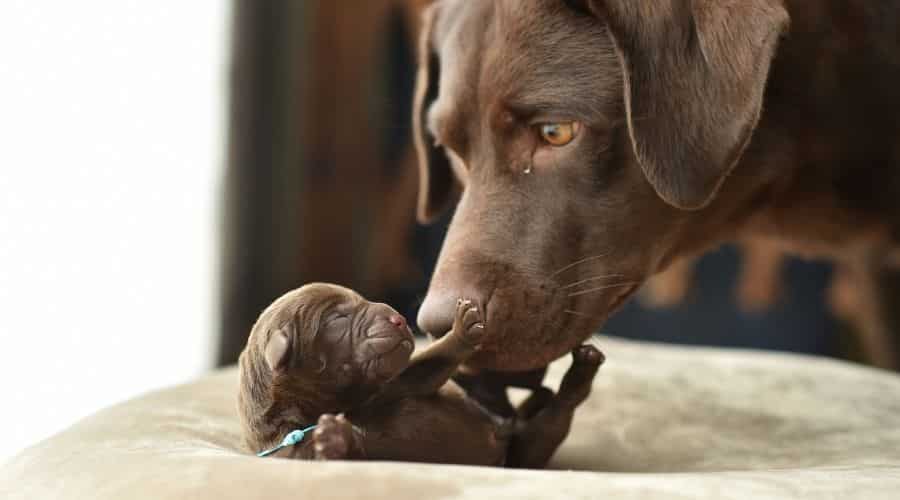
We cover the different things that you need to know about caring for your sporting breed pup at this time. Your dog will grow up quickly, so its best to monitor them closely during every stage of their growth.
Birth To 2 Weeks
You will not be able to do much with your puppy from around the time they are born up to the two-week mark. At this stage, they will not be very interactive since they are both blind and deaf. Your puppy will be totally reliant on their mother for the care needed at this time. If you are also caring for the mother, be sure that shes getting enough to eat so that she can stay strong and give her puppies enough milk. Allow your pup to suckle as much milk as they need. By the two-week mark, your puppys eyes will begin to open, and they will start to hear sounds.
1 Month
At around one month old, your puppy should have developed their senses quite a bit. You will be excited to see them more interactive and social around their littermates. One month old is also when they start to wean off their mothers milk. You can now introduce soft wet food to them at this point. Be sure to allow them to play a lot with their brothers and sisters since early socialization is very important.
2 Months
At two months old, your puppy will be able to survive without their mother. They should be fully weaned off milk now that they are eight weeks old. You can start giving them three meals a day of puppy food, with portion sizes appropriate for their weight. At this point in time, you should start obedience training. They are very receptive when they are this young. This will give you a good foundation for a well-behaved dog. Housetraining shouldnt be too much of a challenge, either. Here is the weight you can expect from two-month-old Labrador Retriever puppies, both male and female. We will continue to make these observations throughout the rest of this section.
- Males: weigh an average of 10 pounds
- Females: weigh an average of 10 pounds
3 Months
You should continue your Labradors training and socialization now that they are three months old. Its a good idea to start leash training them at this time so that they can get used to the feel of the harness and the leash. You should also start grooming them more regularly at this time so they can learn to behave during the grooming process. They will be very rambunctious at this age, so treat them with kindness and patience. Curbing bad behavior and encouraging good behavior is the goal. Three months old is also when you really see a growth spurt. They will be much larger than how big they were a month ago.
- Males: weigh an average of 24 pounds
- Females: weigh an average of 23 pounds
4 Months
Your puppy will be a lot more active and playful at four months old. They should also be happily settled into your home at this point. Continue with their socialization and obedience training, using plenty of positive reinforcement. You may find it useful to enroll both of you in classes for their further training. You can also opt to enroll them in puppy kindergarten classes to help them learn how to behave well around other dogs. This will help them grow up confident and friendly, which is a must for your Labrador.
- Males: weigh an average of 28 pounds
- Females: weigh an average of 27.5 pounds
5 Months
At five months old, youll be very surprised at how big your dog has grown. It may be difficult to rein them in when they are overly playful. Remember to keep your patience with them because they are learning so much so quickly. Positive reinforcement can truly make all the difference in your dog, so be sure to shower them with pets, praise, and treats. Labrador Retrievers have a winning personality, sweet, gentle, and affectionate. However, you can certainly expect your puppy to behave like a puppy for the months to come.
- Males: weigh an average of 41 pounds
- Females: weigh an average of 41 pounds
6 Months
By the time your dog reaches six months old, they will have become very tall and a bit lanky-looking. This phase is awkward but is a testament to just how much they have been growing. You should not overexert them during exercise since they can be prone to injury and, more seriously, hip dysplasia. You will also have established a good routine in your dogs day-to-day life. They will still need you to be firm and consistent with them, so keep it up.
- Males: weigh an average of 45 pounds
- Females: weigh an average of 44 pounds
7 Months
Come seven months old, your dog must be very set in their everyday life with you, having established routines and rapport. You may sometimes catch them trying to be naughty just to see if they can get away with it. Continue to be firm in their discipline, but always reward good behavior when you see it. Now that theyre able to take longer walks, your dog may have made some new friends as they socialize outdoors. You can also give them two meals per day now, provided that they are getting enough food per serving.
- Males: weigh an average of 55 pounds
- Females: weigh an average of 47.5 pounds
8 Months
By eight months old, your dog should now be your best friend, thanks to your strong bond. However, the caveat is that they may develop separation anxiety if you leave them alone for too long of a time. This can lead to destructive behavior and can really damage your dogs mental health. Be sure to have somebody watch them at all times just to make sure that they dont get lonely. Regardless, your dog is on their way to adulthood, filling out their body and maturing very well.
- Males: weigh an average of 57.5 pounds
- Females: weigh an average of 52.5 pounds
9 Months
At nine months old, your dog may start behaving more maturely from time to time, though you cannot really expect this from them very often. Labradors always have a puppy-like quality to them, even if theyve gotten older. Still, your dog may be much more calm and happy to behave more as long as you can meet their energy needs. Take them out for exercise every day, but be sure not to go too vigorously in case you injure them. In their downtime, you can give them toys to stimulate them both mentally and physically. This helps to curb destructive behavior as well.
- Males: weigh an average of 62.5 pounds
- Females: weigh an average of 55 pounds
10 Months
At 10 months old, your dog will continue to fill out their body and keep on growing up strong. Having established a great relationship with your dog, they should be happy to listen to you more often than before. As their body gets stronger, you can start being more active with their exercise, taking around 45 minutes each day for a walk while giving them more time to play at home. This way, you arent overexerting them, and they are able to fulfill their energy needs.
- Males: weigh an average of 65.5 pounds
- Females: weigh an average of 59 pounds
11 Months
Your dog should be very well adjusted to their life at home with you and your family now that they are almost a year old. They will spare no expense in showing your family how much they love them. They are just so happy to be here. At this point, you can try giving them one hour of walk time each day, preferably split into two sessions in the morning and late afternoon. They will also have a lot of fun playing with other dogs at the park since Labradors are wonderfully playful dogs.
- Males: weigh an average of 68.5 pounds
- Females: weigh an average of 59.5 pounds
1 Year
Its time to wish a happy birthday to your Labrador. Now that they have reached this milestone, your home life should be harmonious and easy. Pat yourself (and your dog) on the back for all the hard work you two have done to get them to their behaved, well-trained self.
Your dog will definitely be more mature than when they were much younger, but its good to note that Labrador Retrievers will almost always behave like puppies, even when they are older. That childlike spirit and playfulness is persistent! Continue giving them the right nutrition and exercise for a healthy body that will last a lifetime. A checkup for hip dysplasia is also a good idea around the time when they turn two years old.
- Males: weigh an average of 70.5 pounds
- Females: weigh an average of 61.5 pounds
What Happens Next?

At this point in time, your Labrador Retriever will have done a lot of good growing. However, they will still have more growing to do for the next year or so. This will be weight-wise, as they have already reached their adult height. You can check with your veterinarian to see just how well your dog has grown up. As long as your dog has eaten properly and did not get ill for too long or otherwise injured, they should be fine.
Full Grown Labrador Retrievers
Labrador Retrievers are wonderfully friendly and outgoing dogs, and this should have manifested completely in your well-socialized adult. Male and female dogs will weigh roughly the same throughout most of their puppyhood, with just a little bit of discrepancy in their adulthood.
- Adult Weight: Males grow to an average adult weight of 72 pounds, while females weigh in around 62.5 pounds.
- Adult Height: On average, males are slightly taller, standing 23.5 inches at the shoulder, while females stand at 22.5 inches.
Visit the AKC to gain a firmer grasp on the breed standards for a Lab show dog.
Growth Chart

You can use this as a quick and handy reference to keep with you as your dog grows. However, remember that these are averages; your dog may measure above or below these numbers.
Weight Chart
As you can see from the weight chart, your Labrador Retriever has plenty of growing up to do. You can expect that some months will go faster than others, while some will be slower, especially as they approach their second birthday. Since they get to be quite large, make sure youve trained them not to jump on people when they get excited.
Factors To Consider
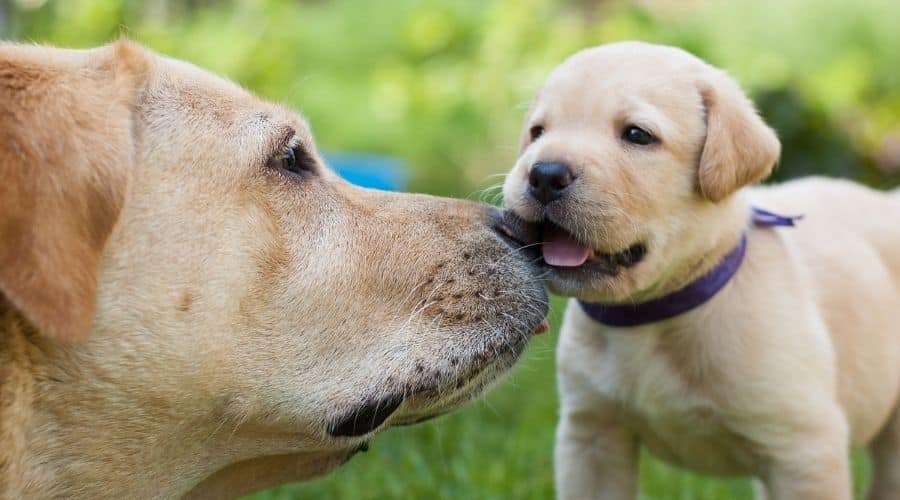
You should think about these as your puppy grows up. This will also help you understand what affects your dogs growth. Some of it is able to be helped, while others are left to chance. This way, you can rest easy in case your dogs growth has not been going the way that you had expected.
Genetics
Your Labrador Retriever is really bred to be a large dog. This is embedded into their genetic code, though some dogs will be bigger or smaller than others. Taking a look at the parents may give you a simple insight into how large your dog is going to grow. However, this is only an estimation and may be completely wrong. Parents are just one piece of the overall genetic picture.
They may carry genes that will result in offspring that are larger or smaller than they are. You cannot really tell until your dog has reached full maturity, so its better to just take it easy and let nature run its course. However, if you like, you can compare notes with your breeder to see how large their other dogs have gotten.
Nutrition
Good nutrition is the foundation of good health for all living beings, including your Labrador Retriever. Nutrition determines a lot about how large or small your dog is going to be. This does not mean that overfeeding will lead to a bigger dog, as this is not always the case. More often than not, this just makes way for obesity and could contribute to orthopedic illnesses. Be sure that your dog is getting enough milk from their mother in the first two months of their life.
After they have been weaned off, they must eat meals that are appropriate for their age and size. Puppy food that is best suited to your Lab is the best option for an optimal balance of nutrients needed to grow up healthy and strong. You can also give them vitamins and minerals to nourish them both inside and out as they grow.
Growth Spurts and Plateaus
Your dog may experience growth spurts and plateaus at any time in their growth period. These will speed up or slow down growth, and there isnt much that you can do about it. You cannot count on growth spurts to happen when you want them to since these effects are random.
Understand that your dog is doing their job in growing up at their own pace. Simply caring for them the way they deserve will really help them grow to their best potential. If you are alarmed by excessive growth or stunted growth, you can ask your veterinarian to see if your Labrador Retriever is growing properly.
Neutering and Spaying
Spaying or neutering your dog at an early point in their life is not really going to do anything to stunt their growth. However, their joints may possibly be affected. Some studies have shown that early spaying and neutering have an effect on the dogs growth plate. This will delay its closure and will thus make your dog grow somewhat taller than they normally would. This is unfortunate, as it predisposes your dog to joint disease later on in their life.
You should ask your veterinarian when the best time is to spay or neuter your Labrador Retriever. As a rule of thumb, you should wait until your dog is 18 months old so that they have reached sexual maturity.
Physical Health
The last factor to consider regarding your dogs growth is their overall physical health. Puppies who have gotten sick early in their lives and have stayed sick for an extended period of time may have their growth stunted. Poor health prevents the body from reaching its fullest potential as they grow, so be sure to bring your dog and for regular checkups at the vet.
Injury may also be a factor in a delay of your dogs growth. Your Labrador should not overexert themselves during playtime and exercise while they are growing up. Give them plenty of space to play so that they do not accidentally bump into walls or objects and hurt themselves and the process.
When your dog is young, the time is right to consider pet insurance. If you get it before they suffer injuries or illness, you will get the full value of your policy since there are no pre-existing conditions to exclude from your coverage. And if you come up against a super high vet bill as a result of your curious Lab getting into some dangerous trouble, pet insurance allows you to make the best health decision without worrying about the expenses of treatment.
Frequently Asked Questions

Before we end this guide, we will be answering some of the most frequently asked questions from Labrador Retriever owners who may be anxious about their dogs growth. We have answered five of the most common queries below.
When will my Labrador Retriever stop growing?
Your Labrador Retriever will grow up at a fairly steady pace and will end up being larger than many other dogs. While your dog may act like a puppy for the rest of their life, their physical growth stops around 18 months to two years of age. Labradors reach their adult height somewhere around a year old but continue to bulk up in weight until they are two years old.
How fast will my Lab grow?
Labradors do not grow at an astonishing pace, but they still grow up fast, especially when they are very young. In the early weeks, they can sometimes gain up to 10 pounds in a month, which is very impressive. Beyond this, your dog may also undergo plateaus and growth spurts. Taking a look at the parents can give you a rough idea of how large your dog is going to grow, but there is no guaranteed way to tell.
Many dogs start out small and then grow much larger. On the other hand, many dogs are larger than their littermates but hit a plateau and stop growing as quickly. Try not to have expectations that are too precise since every dog is an individual.
Will my puppy experience growing pains?
Studies show that dogs do not really experience growing pains while they are puppies. However, your dog may have certain orthopedic conditions that can bring them pain. If you see them limping or notice swelling, an unusual gait, or a reluctance to join normally fun activities, then you should see your veterinarian. This will get your puppy sorted so that they can get back to growing in no time at all.
Take care not to allow your dog to injure themselves from playing too roughly or exercising too much. This will definitely cause them pain, so only allow your dog to handle themselves in a safe and healthy way.
What are some conditions common to Labs?
One common condition that your dog can develop as they grow up is hip dysplasia. This is a disease common to Labradors where the thigh bone does not fit properly into the hip socket. This can bring them a lot of pain and will often lead to degenerative arthritis later on in their life. You can spot hip dysplasia if you notice your dog limping, walking strangely, or standing awkwardly.
Bring your Labrador to the vet when they are two years old to see if hip dysplasia has developed. Good breeders will screen for this disease and do not allow dogs who have it to breed. If you have received your puppy from a reputable breeder, chances are they are safe from hip dysplasia. You can find reputable breeders at the National Labrador Retriever Club.
What if my Lab isnt the correct weight?
If you find that your dog does not weigh the right weight, you can address this in a few different ways. Your dogs weight will always depend on how large they have become with regard to size. Dogs do tend to gain weight as they grow older.
To test if your dog is overweight or underweight, you should check their ribs. You shouldnt be able to see them at all, but if you can, this is a clear indicator that your dog is underweight. You should be able to feel the ribs by lightly pressing down on them. Needing too much pressure to feel the ribs means that your dog has gotten overweight and will need to go on a diet to correct this. It might be time to consider a healthy weight management dog food.
They will also need to engage in more exercise. Underweight dogs need immediate veterinary assistance. You may need to have them dewormed in case of internal parasites. You should always consult your veterinarian for treatment plans if your dog is overweight or underweight.
Final Thoughts
Your Labrador Retriever is going to grow up into a handsome, playful pup. Its up to you as their pet parent to make sure they grow up healthy. You may run into a few obstacles along the way, but this is true of taking care of any dog. Having the correct information can help make things easier for both you and your dog. Now, you are prepared to give your dog the care they need to grow up well.
There is a lot to think about, so its good that you research and know what to expect. Understanding the different factors that go into your dogs growth will also help clear any anxieties about your dog growing up. Our last recommendation is to always bring your dog in for their routine checkups at the vet. This way, you can see if your dog is reaching their full growth potential.

